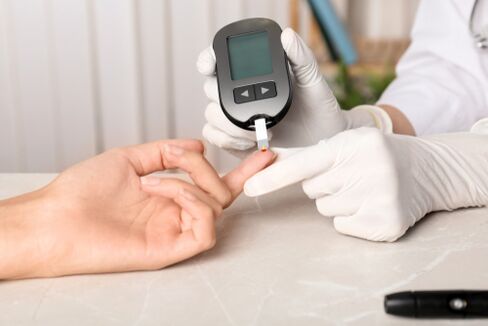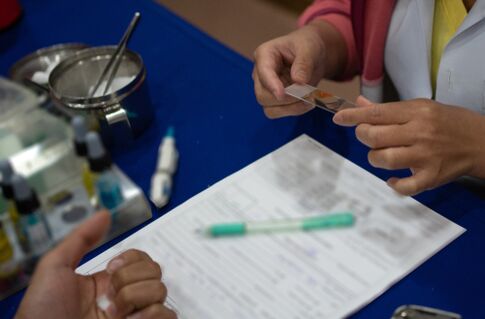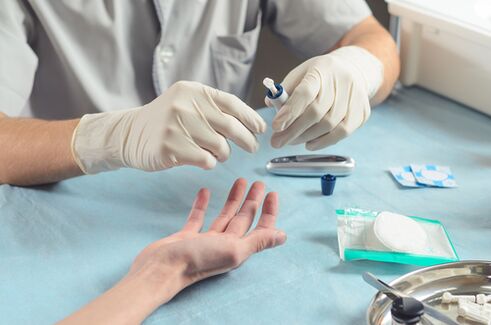
Diabetes mellitus is a chronic endocrine disease characterized by the inability to absorb glucose from food and be necessary for nutrition, breathing and energy metabolism from cells. In this case, the production or interaction with the hormone of the pancreas - insulin is affected. It is necessary to regulate the quantitative presence of glucose in the bloodstream. With improper operation of a couple of glucose sensulin, hyperglycemia is a continuing increase in glucose. The metabolism suffers, the work of kidneys, heart, blood vessels and central nervous systems is disturbed.
Types of diabetes
There are two main varieties from diabetes that, although they belong to a group of endocrine diseases, still have differences.
First type of diabetes (insulin -dependent, juvenil, inzsd i -Type)
It is characterized by the fact that the immune system attacks the pancreas beta cells (more than 80%) for some reason and produces insulin. There is no hormone, but glucose is constantly delivered to the body with food. Blood sugar goes out of the scale. The first type diabetes are most often found in childhood or youth. But it is not unusual for adults.
Second type diabetes (insulin -dependent, II II II)
Type II diabetes is diagnosed more often in humans after 30-40 years. But the disease gets younger. Excess weight is observed in 90 % of cases in patients. The body can still produce insulin, but the sensitivity of the cells compared to insulin is reduced (this is referred to as insulin resistance). A vicious circle is created. Cells do not feel insulin, the body produces even more insulin to feed; Cage. Glucose simply accumulates in the blood and insulin increases appetite. One person eats, jumps sugar, reinforced insulin resistance.
Prediabet
Here the glucose level goes beyond the reference values, but they cannot even talk about diabetes. Prediabet can be the basis for the development of type -II diabetes and diseases of the cardiovascular system.
Pregnancy diabetes is characteristic during pregnancy. Most often found in the II or III trimester.
The course of the disease also differs in severity: light (i), medium (II) and heavy (III).
Diabetes. Symptoms
If you do not even donate blood for glucose every year and do not personally know the endocrinologist from the clinic, there are a number of symptoms that can tell you that it is time to contact a specialist. However, we will immediately make a reservation, the signs of diabetes manifest themselves if the insulin deficiency already moves to a critical point. At the moment the most effective way is to find out that your sugar level can donate blood.

Diabetes of the first type
Symptoms of diabetes of the first type:
- Constant, insatiable thirst;
- dry mouth;
- frequent urination;
- Apathy and fatigue;
- insatiable hunger;
- Weight loss (average 3-5 kg), not related to a person's actions;
- Problems with seeing (indefinence of the image, as if everything is in the fog).
Diabetes of the second type
In some parameters, the symptoms of diabetes of the second type resemble the type -i -diabetes: it is thirsty, hunger, dry mouth, tiredness, visual problems and more frequent to the toilet. However, this type has its own signs:
- Taub and tingling in the arms and legs;
- Slow wound healing and recurring infections.
The causes of diabetes

Unfortunately, scientists cannot name the exact causes of the development of diabetes in humans (especially the first type). Bad ecology, an abundance of viral infections and inadequate operation of the immune system are assumed as the basis. The causes of the development of diabetes mellitus are usually differentiated:
- Hereditary disposition. In addition, the risk reaches 10%if the father is sick with the first type diabetes, and 2, 5%if the mother. If both parents are diagnosed with type II diabetes, the child has the risk of a disease after 40 years to 65-70%.
- Incredible diet with a wealth of carbohydrates;
- Obesity (90% of people with type -ii -inzsd);
- Lack of physical activity;
- constant stress;
- Prediabet;
- longer use of certain medication (diuretic, hormone, salicylate, cytostatics, etc. );
- Ethnicity (in children of the European breed the risk of developing diabetes of the 1st type higher);
- History of pregnancy diabetes;
- Chronic insufficiency of the adrenal cortex.
Complications
This disease is insidious, and if you do not observe the doctor's instructions, complications of diabetes (chronic and acute) can occur that endanger the work of the entire organism. Chronic complications are observed when a high sugar level takes a long time.

The following chronic complications can be differentiated:
- The fragility of blood vessels in retina (retinopathy) leads to a decrease in visual acuity, the early development of cataracts or blindness.
- Diabetes often occurs to periodontitis, which leads to loss of teeth or problems with the heart. In addition, a variety of infectious diseases of the oral cavity are possible. It is necessary to observe hygiene well and to visit the dentist regularly.
- Cardiovascular diseases are the most common causes of disability and mortality among diabetics. Angina pectoris, myocardial infarction, stroke and others. A lack of observation of the cholesterol and glucose mirror, increased blood pressure contributes to the development of these complications.
- Nephropathy or the destruction of blood vessels in the kidney leads to failure to function or reject the kidneys. Hell control is required.
- Neuropathy (nerve damage). Most of the time, the risk of neuropathy is exposed to legs. The walls of the vessels and nerve fibers are destroyed, the blood flow to the legs worsens. Signs of the development of neuropathy are tingling, pain, crawling hostility or loss of sensitivity. Patients, especially older people, usually do not combine the importance of what is affected with the development of sausages, infectious diseases and amputation. Neuropathy can influence other body systems (erectile dysfunction, problems with the stomach intestine tract, the genitarianrinary).
- Diabetes is one of the causes of atherosclerosis because the vessels are brittle, fragile and increase the risk of a thrombus.
- There is often joint pain because diabetes leads to a decrease in the amount of synovial fluid.
- There is also a high frequency of developing mental disorders.
Acute complications that develop quickly are usually associated with blood sugar fluctuations. Low (hypoglycaemia) and high (hyperglycaemia) lead to crises. The crisis of hypoglycaemia (3, 9 mmol/l or lower) manifests itself as a seizure, and hyperglycemic crises are dangerous for the occurrence of diabetic ketoacidosis and hyperosmolar hyperglycemic condition. These are emergency and threats that lead to cramps, coma and fatal result.
Diagnosis of diabetes
The diagnosis of diabetes is an important step. In an ideal situation, a person should be aware of his glucose mirror, especially after 45 years. However, if it is endangered, the analysis should be carried out more often and you have to do this earlier so as not to miss the precious time.

Diabetes are diagnosed in different ways:
- Analysis for glycated hemoglobin. The results of the analysis show the average glucose degree of glucose in the blood in the past 2-3 months. So you can follow the dynamics.
- Analysis of glucose in the blood plasma (capillary or venous) on an empty stomach. The audit shows the position of glucose at the moment;
- The gluczotlerant test is prescribed in dubious cases. The test lasts quite a long time and includes a measurement of the glucose mirror before and after taking a glass water with glucose dissolved in it.
- Analysis of the urine for the presence of glucose and/or acetone. A healthy person is not characterized by the presence of these elements in the urine.
Treatment

When treating diabetes mellitus of type I type I, the main treatment for insulin is the main treatment for insulin, which must be administered daily in a dose prescribed and calculated by the applicable doctor. You can use special insulin injections, syringe handrails or insulin pumps and independently calculate the required dose of the submitted hormone. Under certain conditions, it is possible to prescribe medicines for diabetes that encourage the body to develop its own insulin.
In diabetes in the first species, chip insulin is every day because the passports with the development of diabetic ketoacidosis are affected, which leads to death. Daily insulin + correct nutrition + physical activity can give life without complications.
In type -II diabetes, a doctor prescribes drug treatment to lower the sugar level and normalize the condition of a person. Sometimes it may be necessary for substitution therapy by insulin, but does not have to be received every day. Dietary diet is observed without failure and an increase in physical activity and body weight control.
In the presence of pre-diabetes, the examination must be carried out once every six months or a year. It is also necessary to get rid of excess weight and change to nutrition of nutrition.
In pregnancy diabetes, it is necessary to carefully monitor the glucose level in the blood and to follow the attentive doctor's recommendations. Most of the time, blood sugar returns normally after birth after birth. However, there is a risk of developing the second type diabetes.
Prognosis and prevention
Diabetes mellitus is a serious endocrine illness that reduces life by 5 to 10 years, and men die more often than women. Infection and viral diseases are more tolerated. Complications against the background of pneumonia, influenza, occur 6 times more often compared to statistics by humans without diabetes in a story. In healthy people, Alzheimer's and other forms of dementia develop less frequently compared to diabetics.

But with diabetes they can and should be fought. Competent management helps you to avoid many problems and complications. 50-60% of the disease cases are stabilized and not advanced.
The correct control and prevention of diabetes is:
- Regular glucose test;
- special diet for diabetes;
- Sport in moderate mode play sports;
- Observation of blood pressure and cholesterol;
- Regular visit to the necessary specialists and examinations;
- Taking medication that is prescribed by a doctor.
Diabetes is not completely examined, but medication and a conscious attitude to your life with this disease will help to live long and without complications.


























